Automotive seating research: automotive seating enjoys an amazing boom in the context of autonomous driving.
As autonomous driving develops, vehicles, a simple mobility tool, are tending to be positioned as a "third mobile space" centering on human-vehicle interaction experience. As an important part of the "third mobile space", seating is also evolving in an intelligent direction. This report summarizes the main development trends of the automotive seating industry by combining the planning and layout of the world's major automotive seat suppliers and the seat configurations of marketed vehicle models and concept cars of OEMs in recent years.
1. Seating becomes more comfortable and intelligent.
From January to August 2022, China demanded 63.09 million units of new automotive seats, of which fabric, leather and artificial leather ones shared 21.7%, 18.8% and 47.8%, respectively. In terms of seat functions, seat heating boasted an installation rate of 7.9%, and 52.2% of vehicle models priced at RMB100,000-250,000 installed this function; the installation rate of seat ventilation stood at 2.7%, and 55.3% of vehicle models priced at RMB100,000-250,000 carried this function, of which the RMB100,000-200,000 models showed a rising installation; the installation rate of seat massage reached 1.1%, and the percentage of RMB200,000-350,000 vehicle models packing this function reached 49.0%, a surging rate mainly driven by Volkswagen ID Series, AITO, TANK 300 and Li Auto ONE.
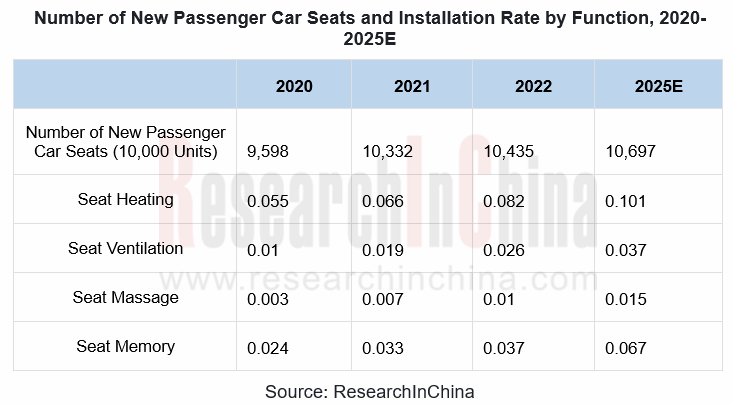
2. Carbon fiber composites become the first choice for lightweight seats.
Carbon fiber composite is a structural material compounded by carbon fiber and metal, ceramics, resin, etc. This lightweight, high strength material with a quarter of steel density and tensile strength higher than 3500Mpa, is a very suitable alternative to metal materials to make seat frames.
For example, in April 2021, Nobo Automotive Systems displayed a carbon fiber frame seat at the Shanghai International Automobile Industry Exhibition. The back frame of this seat is integrally formed with carbon fiber composites, and uses a small number of parts, reducing the weight by a staggering 35%. The high-end carbon fiber seat introduced by Zhejiang Tiancheng Controls in November 2021 adopts one-piece molding, thermosetting and injection molding processes, with weight about 30% lighter than conventional steel ones.
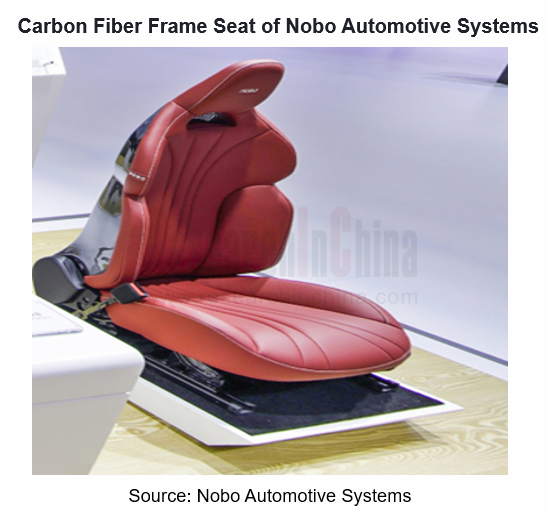
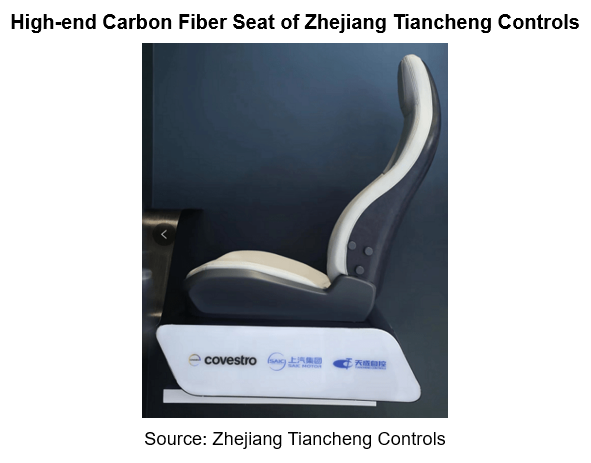
As well as use of new materials, suppliers also reduce seat weight through structural optimization and manufacturing processes.
For example, the UltraThin seat launched by Adient in August 2022 adopts the seat construction of thermoplastic elastomer (TPE) panels, reducing overall seat trim outline volume by 30%, overall seat part count by 10%, and overall mass by 14%.
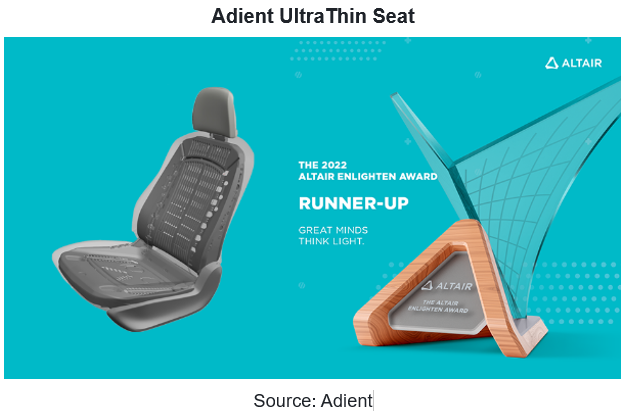
3. Recyclable and renewable materials help to achieve the goal of carbon neutrality.
In response to energy conservation and emission reduction, suppliers put more focus on "green" and renewable eco-friendly materials in seat design and development.
For example, in August 2022, Faurecia launched a new eco-friendly seat. The seat cover material is a recyclable material with a recycling rate of 85%, reducing 52% carbon emissions compared with conventional cover materials; the seat headrest filler uses foam material, a lightweight recyclable material based on the concept of blended fibers, with a recycling rate of up to 70%, slashing 56% carbon emissions. In February 2022, Hyundai Transys unveiled its future green mobility concept seat, a new seat concept co-created with Italian and Korean manufacturers using leather waste. The seat part uses recycled tanned leather; the seat backrest uses woven leather; the seat headrest is structured using recycled aluminum powder.
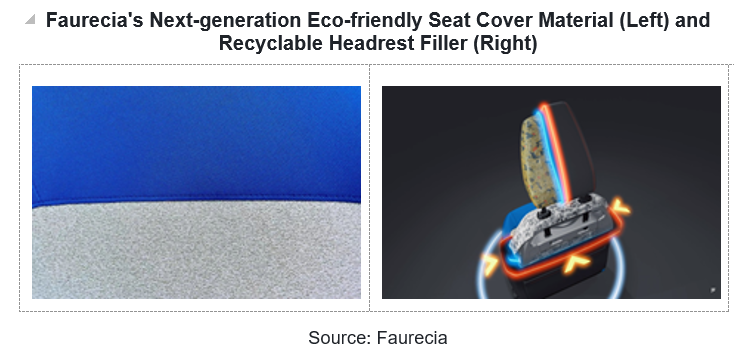
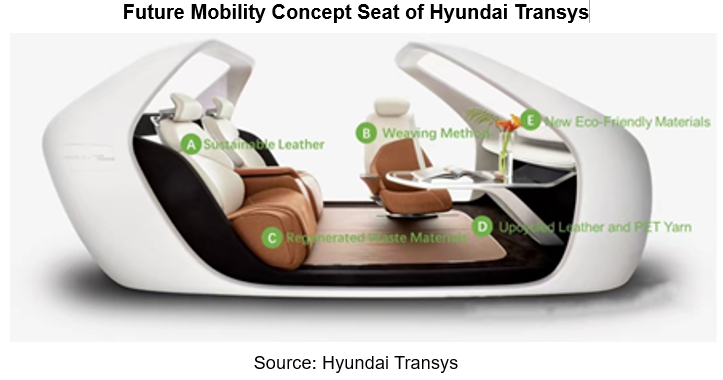
4. Intelligent technology redefines automotive seating comfort.
Intelligent adjustment seats can be adjusted via mobile phone, voice or intention perception. For example, the SU seat launched by Yanfeng in 2022 has a pneumatic backrest that can sense the pressure distribution and adjust adaptively according to changes in the passenger's body size and sitting posture; the four-way pressure-sensitive headrest can automatically recognize the occupant's head position to intelligently adjust the height.
Xpeng G9 marketed in September 2022 packs an ultra-low frequency rhythm seat provided by Adient. The seat can vibrate with the beat of music, and move with the plot of the film source. Using artificial intelligence and other technologies, Hyundai Transys provides comfortable ride experience that matches body sizes of occupants, for example, the seat can make active adjustments according to body size, posture and habits of occupants.
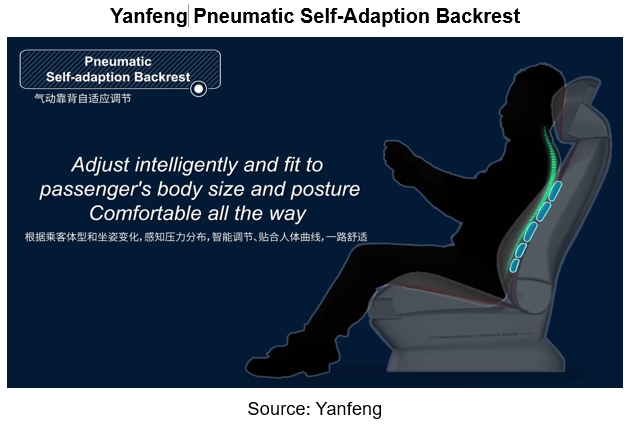
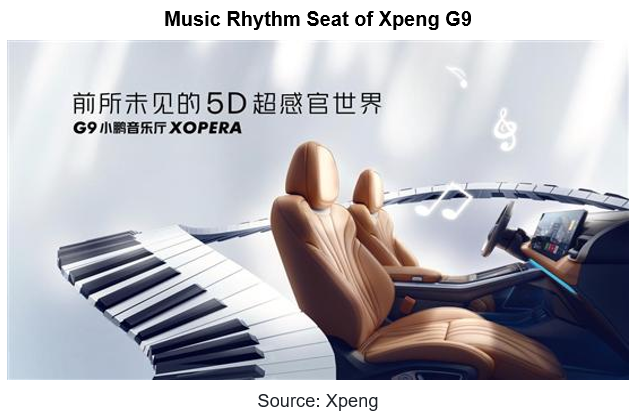
The intelligent health sensor automatically senses health indicators such as heartbeat and breathing rate via the non-contact sensor installed inside the seat, and then automatically provides intelligent adjustments such as massage, music play and ambient light control, according to physical state. For example, in March 2022, Toyota Boshoku announced an IoT seat cover equipped with two systems: the fatigue estimation system that uses a built-in sensor to measure the driver's heart beat and thereby estimate their state of fatigue; the active driver engagement system that vibrates the seat cover and plays music accordingly to suppress drowsiness.
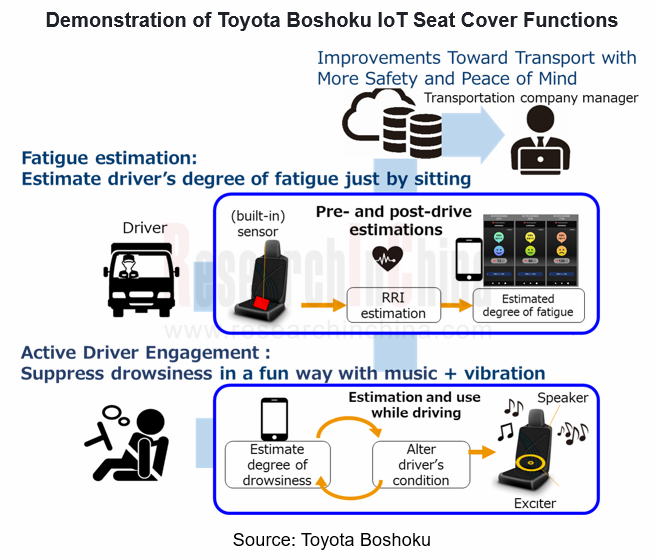
Smart surfaces not only allow touch control on seats instead of conventional buttons, but display information. For example, the zero-pressure seat, integrated luxury seat and SU seat unveiled by Yanfeng in 2022 all pack smart touch control armrests that enable such functions as seat position adjustment, seat ventilation, heating, massage and leg drag, as well as one-button activation of zero-pressure posture.
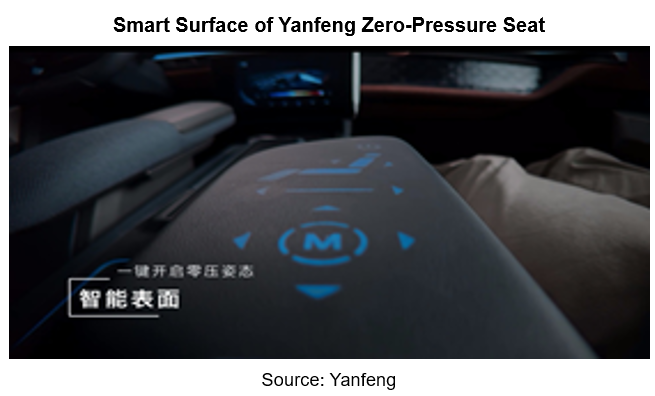
5. The "changeable cockpit" in the autonomous driving environment.
In the future, vehicle cockpits will not only be used for riding, but enables switching between different scenarios by flexibly adjusting seats, so as to meet people's needs.
For example, in the new intelligent cockpit IRS3.0 launched by South Korea's DAS Corporation in 2021, the seats carry ultra-long slides and allow 360° omnidirectional rotation, realizing six scenarios including social contact mode, conference mode and comfort mode. The cinema-style folding seat released by Yanfeng Seating in 2022 can be folded and slid to enable scenarios like commuting mode, family mode, travel mode and joy mode.
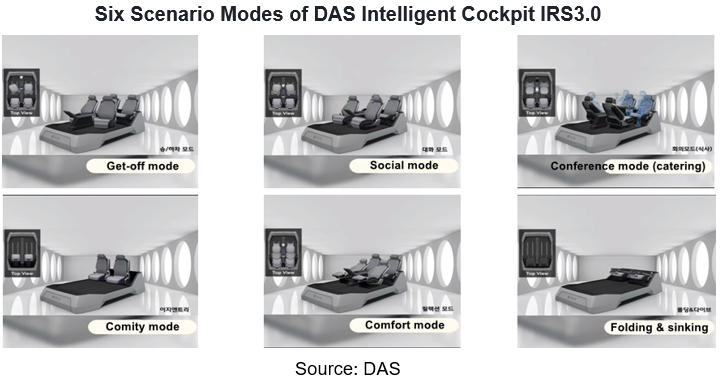
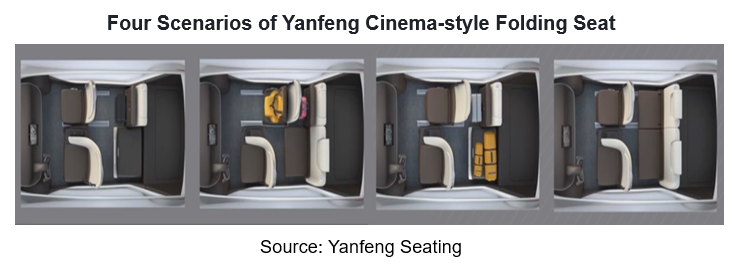
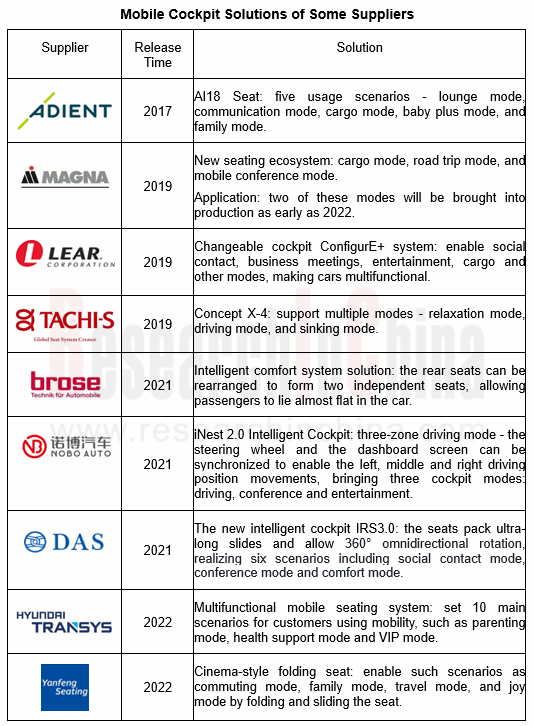
Automotive Vision Industry Report, 2025
Automotive Vision Research: Average Camera Installation per Vehicle Reaches 5.2 Units, and Front-View Tricam Installation Exceeds 1.2 Million Sets.
From January to September 2025, the total installa...
Automotive Infrared Night Vision System Research Report, 2025
Automotive night vision research: The rise of infrared AEB, with automotive infrared night vision experiencing a 384.7% year-on-year increase from January to September.
From January to September 2025...
New Energy Vehicle Cross-Domain (Electric Drive System and Powertrain Domain) Integration Trend Report 2025-2026
Electric Drive and Powertrain Domain Research: New technologies such as three-motor four-wheel drive, drive-brake integration, and corner modules are being rapidly installed in vehicles.
Electric dri...
Analysis on Desay SV and Joyson Electronic's Electrification, Connectivity, Intelligence and Sharing, 2025
Research on Desay SV and Joyson Electronic: Who is the No.1 Intelligent Supplier?
Both Desay SV and Joyson Electronic are leading domestic suppliers in automotive intelligence. "Analysis on Desay SV ...
OEMs and Tier 1 Suppliers' Cost Reduction and Efficiency Enhancement Strategy Analysis Report, 2025
ResearchInChina released the "OEMs and Tier 1 Suppliers' Cost Reduction and Efficiency Enhancement Strategy Analysis Report, 2025", summarizing hundreds of cost reduction strategies to provide referen...
Automotive Fixed Panoramic Sunroof and Smart Roof Research Report, 2025
With the intelligent application of car roofs as the core, this report systematically sorts out a series of new products such as fixed panoramic sunroof/openable sunroof, ceiling screen, roof ambient ...
Automotive-Grade Power Semiconductor and Module (SiC, GaN) Industry Research Report, 2025
SiC/GaN Research: Sales volume of 800V+ architecture-based vehicles will increase more than 10 times, and hybrid carbon (SiC+IGBT) power modules are rapidly being deployed in vehicles.
Sales volume o...
Cockpit Agent Engineering Research Report, 2025
Cockpit Agent Engineering Research: Breakthrough from Digital AI to Physical AI
Cockpit Agent Engineering Research Report, 2025 starts with the status quo of cockpit agents, summarizes the technical ...
Prospective Study on L3 Intelligent Driving Technology of OEMs and Tier 1 Suppliers, 2025
L3 Research: The Window of Opportunity Has Arrived - Eight Trends in L3 Layout of OEMs and Tier 1 Suppliers
Through in-depth research on 15 OEMs (including 8 Chinese and 7 foreign OEMs) and 9 Tier 1 ...
China Commercial Vehicle IoV and Intelligent Cockpit Industry Research Report 2025
Commercial Vehicle IoV and Cockpit Research: The Third Wave of Passenger Car/Commercial Vehicle Technology Integration Arrives, and T-Box Integrates e-Call and 15.6-inch for Vehicles
I. The third wav...
Intelligent Vehicle Electronic and Electrical Architecture (EEA) and Technology Supply Chain Construction Strategy Research Report, 2025
E/E Architecture Research: 24 OEMs Deploy Innovative Products from Platform Architectures to Technical Selling Points
According to statistics from ResearchInChina, 802,000 passenger cars with domain...
Research Report on Intelligent Vehicle Cross-Domain Integration Strategies and Innovative Function Scenarios, 2025
Cross-Domain Integration Strategy Research: Automakers' Competition Extends to Cross-Domain Innovative Function Scenarios such as Cockpit-Driving, Powertrain, and Chassis
Cross-domain integration of ...
China Autonomous Driving Data Closed Loop Research Report, 2025
Data Closed-Loop Research: Synthetic Data Accounts for Over 50%, Full-process Automated Toolchain Gradually Implemented
Key Points:From 2023 to 2025, the proportion of synthetic data increased from 2...
Automotive Glass and Smart Glass Research Report, 2025
Automotive Glass Report: Dimmable Glass Offers Active Mode, Penetration Rate Expected to Reach 10% by 2030
ResearchInChina releases the Automotive Glass and Smart Glass Research Report, 2025. This r...
Passenger Car Brake-by-Wire (BBW) Research Report, 2025
Brake-by-Wire: EHB to Be Installed in 12 Million Vehicles in 2025
1. EHB Have Been Installed in over 10 Million Vehicles, A Figure to Hit 12 Million in 2025.
In 2024, the brake-by-wire, Electro-Hydr...
Autonomous Driving Domain Controller and Central Computing Unit (CCU) Industry Report, 2025
Research on Autonomous Driving Domain Controllers: Monthly Penetration Rate Exceeded 30% for the First Time, and 700T+ Ultrahigh-compute Domain Controller Products Are Rapidly Installed in Vehicles
L...
China Automotive Lighting and Ambient Lighting System Research Report, 2025
Automotive Lighting System Research: In 2025H1, Autonomous Driving System (ADS) Marker Lamps Saw an 11-Fold Year-on-Year Growth and the Installation Rate of Automotive LED Lighting Approached 90...
Ecological Domain and Automotive Hardware Expansion Research Report, 2025
ResearchInChina has released the Ecological Domain and Automotive Hardware Expansion Research Report, 2025, which delves into the application of various automotive extended hardware, supplier ecologic...